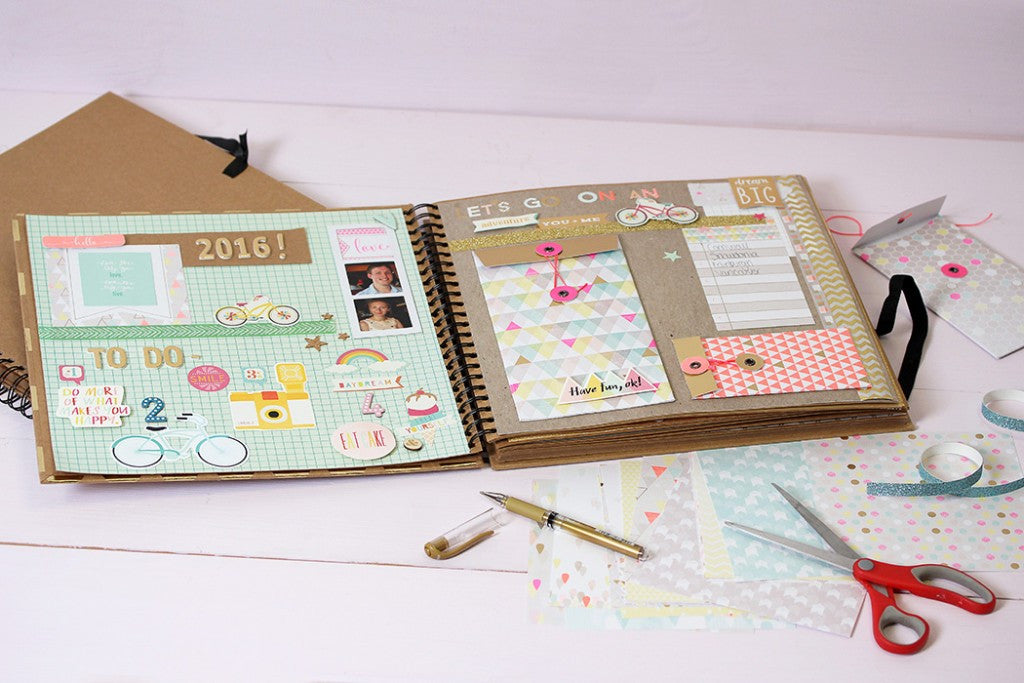
How to choose the best, free digital scrapbook background
Posted by Olivia Sum on
Using Lots of Colour
Using colour is one of my favourite parts of scrapbooking. Yet new scrappers often tell me they feel overwhelmed by it. They hear a phrase like “tertiary colours” and feel they need to take an art class or consult a colour wheel before picking their papers. That’s basically not true! If you can get dressed in the morning, you can choose the right colours for your page.
Part of selecting colours will be influenced by your personal taste. I LOVE red, and choose it frequently for my pages (and for my cards, and clothes and all through my home). You might be partial to blue, green or brown. You may love happy colours, or desire more elusive earth tones. Go with your instincts. You’ll find the colours you love are easier and more fun to work with—and scrapbooking is, after all, about having fun.
My Colour-Picking Procedure

I always choose my paper based on colour. Don’t worry about finding a paper decorated with the picture-perfect theme. I know scrappers who drive themselves wild because they feel they can’t scrapbook those gymnastics photos on anything other than paper mottled with little gymnasts. It’s a very restraining way to approach scrapbooking, and will make the progression very slow!
Instead, I choose a paper colour that looks good with my photo. I’ll pick a few papers I like, then place the photo on top and see how it looks. Some papers habitually look great, and others don’t. If you can’t adopt, stand up and look down at your paper and photo to get a different viewpoint, or walk away for a few minutes and come back to it.
The Status of Photo Mats
I always mat my photos before putting them on my background paper—even if my background is a compact colour, and particularly if I’m using a patterned paper background. A mat is just a paper frame for your photo. Here’s how to do it: Glue your photo onto a solid paper, then trim a boundary around the edge of the photo. I leave anywhere from a 1/16” border to 1/2” border. A white or cream mat can help lift dark photos, while a black or navy mat enhances light photos. You can use a collared mat, too—but when in doubt, black and white are always a safe bet. For digital scrapbooks – just cut, paste and add.
Make Sure the Photo Stands Out
Placing a dark photo on a murky background can look, well...dark. Slip a piece of sunlit paper or cardstock beneath the photo as a transitory mat and see if that makes a difference. If not, opt for a lighter paper—and vice versa. If the colours in the photo are light, a dark background paper will make the picture stand out.
For example, a child sitting on the grass will always look virtuous on a green background paper. A photo with lots of blue sky will look great on a blue or grey paper. Equally, another option is a paper that differences those colours.
Match or Contrast the Clothing Colours in the Photo
This tip shadows the same principle of equivalent or contrasting. For example, a bride in a white dress will look gorgeous on a white or a black background paper. If your photo has a lot of diverse (or clashing) colours, you can always change your colour photo into black and white and put it with any paper you want! Changing colour photos to black and white also helps minimalize patterns or graphics on the subject’s clothing—it’ll tone down your brother-in-law’s Hawaiian shirt and the Little Mermaid on your daughter’s cute bathing suit. It also makes photos a little more real.
Match the Mood of the Photo

Colour is about assigning a message. An official wedding looks tremendous when scrapbooked with delicate colours, as do mature legacy photos or formal portraits. Kid’s pages, however, are flawless on lively, vibrant backgrounds that carry energy and excitement.
Colour Associations
We’ve all practiced colour association: Baby boys wear blue, little girls wear pink. Colour association can make it quicker and calmer to select scrapbooking paper, too. Don’t have Christmas paper for your holiday design? Then pick a red and green plaid paper to induce the theme instead!
Getting Warm, Staying Cool
When you start to feel relaxed with colours and decorations, you might start using “warm” and “cool” colours. “Warm” colours comprise of red, orange, peach and yellow, while “cool” colours are blue, purple and teal. Warm colours commonly look good together, as do cool colours.
If your background paper is brown, try a cream colour paper as a photo mat instead of a plain white. Mat with the white when your background paper is a shimmering blue. And yes, you can merge warm and cool colours —there are omissions to this rule! For example, red, white and blue look excessive together!
Naturally Neutral
Neutrals are the great essentials of colour —those colours which don’t contest with other colours. White, off-white, grey, black and beige are all neutral colours and you can use these for just about any look or subject.
So you see—using colour is really just about what makes your photo look superlative. And you, after all, are the critic of what looks good on your page. Have fun, try-out and enjoy using colour!
Share this post
- Tags: backgrounds, colour, digital-scrapbook, scrapbook, tutorial
